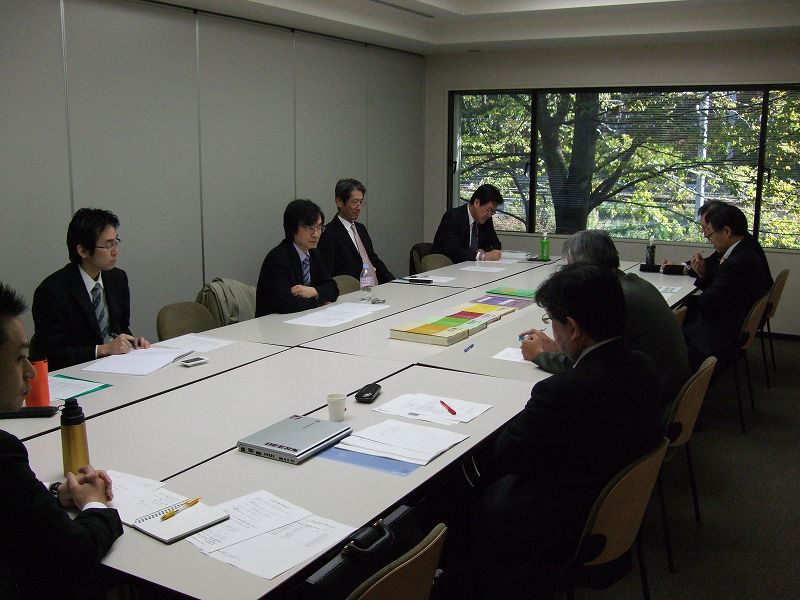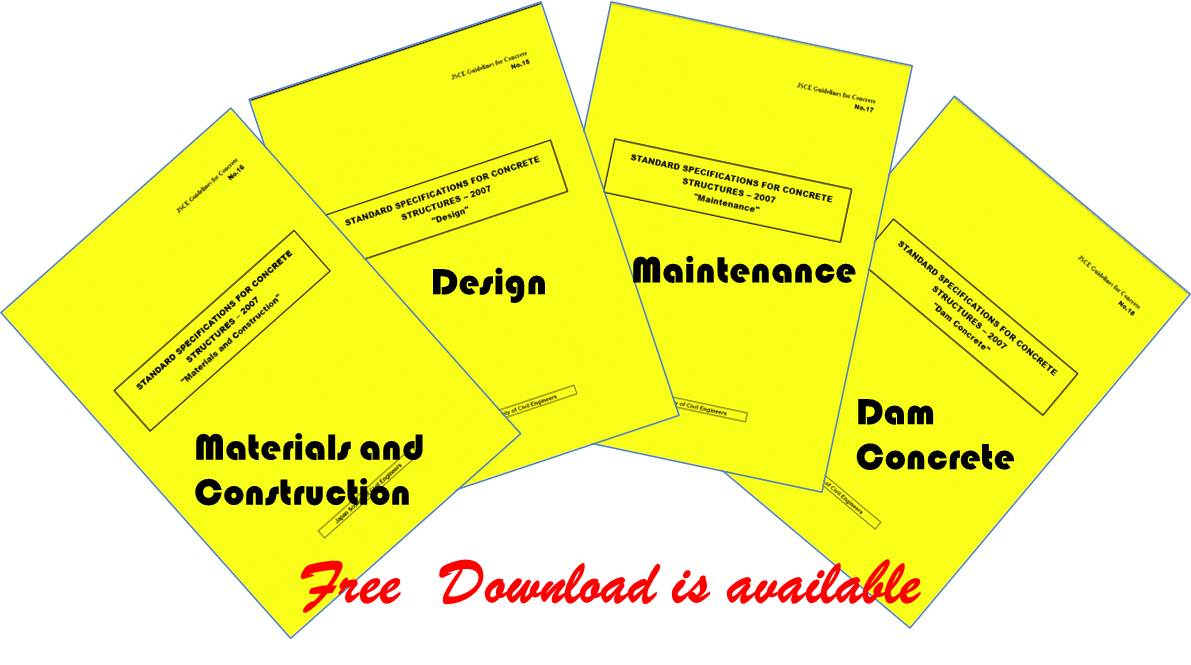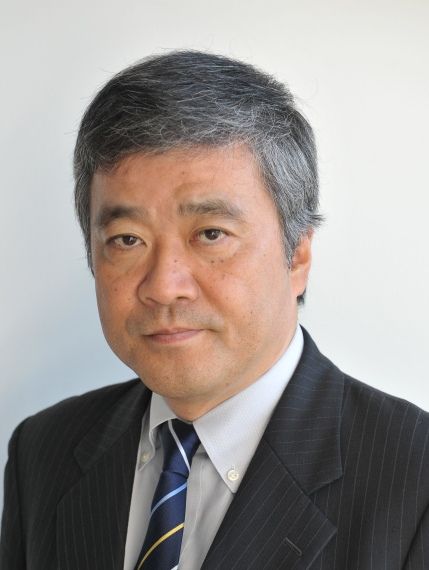Introduction
The JSCE Concrete Committee is engaged in many activities as the leading organization for surveys, research,
development of technology, and education in the concrete engineering of Japan.
But the most important of these activities is the publishing and revising the “Standard Specifications for Concrete Structures”
which prescribes the planning, design, construction, and maintenance management of concrete structures.
The Standard Specifications for Concrete Structures is formulated based on the technical level at the time
so that structures are constructed to a certain quality standard or higher.
Since the first publication of “Standard Specifications for Reinforced Concrete” in 1931,
it has undergone major revisions once about every 10 years in keeping with the progress of concrete technology,
and in between, there have been minor revisions.
Lately, however, essential revisions are made without clearly distinguishing between major and minor revisions.
Intent and Characteristics of the Revisions
The major characteristic of the 2012 revision is that a new “General Principles” part has been incorporated.
Although formerly published as a single part, in the major revision in 1986, the Standard Specifications was published in several parts.
Thereafter, as the content of each part increased, it became more difficult to see the relationship between the principles of
the specifications and each part.
As a result, immediately after publishing the 2002 revision, the necessity of a "Common Part (Provisional Title)” that would
provide an overview of the entire standard specifications for concrete was discussed at the Specification Communication
Coordination Subcommittee (which was instituted intermittently for two periods over four years), and the Specification Revision
Subcommittee (which was continuously active).
Then the content of “Application of the Standard Specifications for Concrete,” which describes the assumptions and concepts
that were common to each of the parts at the previous revision in 2007, was continued and further greatly enhanced,
and was then newly adopted in this revision as a separate part with the name changed to "General Principles.”
Consequently, the Standard Specifications for Concrete Structures now consist of six parts:
General Principles, Design, Materials and Construction, Maintenance, Dam Concrete, and Specifications.
The Design and Materials and Construction parts which were revised to incorprate the technical advances made since 2007,
retain the basic configuration of a combination of “General Requirements” based on performance verification and
performance requirements, and “Standard Methods” to enable easy use by limiting the scope of application,
to give an improved and complete standard.
In order to equalize the discussion of specification revision in the Specification Revision Subcommittee and
the Concrete Permanent Committee, it was decided to postpone the publication of the parts on Maintenance and
Dam Concrete by about 6 months, for which revision has been proceeding in parallel.
The 2013 edition of the “Specifications” part is scheduled to be published.
Details of the Main Revisions in Each Part of the Standard Specifications for Concrete Structures
- General Principles Part
In the 2007 edition of the Standard Specifications for Concrete Structures, a section titled
“Application of Standard Specifications for Concrete Structures” was provided at the beginning
of each part, which described the basic concepts of the Standard Specifications for Concrete Structures,
the role and deployment of the responsible engineer, and systems for ensuring reliability.
The General Principles part further enhanced this content with the objective of making the basic concepts
and systems that are common in the whole Standard Specifications for Concrete Structures more easily understood.
In addition, by including environment in the role of the Standard Specifications for Concrete Structures,
the stance that the Standard Specifications for Concrete Structures contribute to the development of a sustainable
society was clearly indicated.
The General Principles part consists of five sections.
In Section 1 General, the objectives of the Standard Specifications for Concrete Structures and of each of the parts
comprising it as well as their scope of application are described, as well as the role of concrete structures in society.
In order to realize reliable concrete structures that contribute to society, it is necessary to clearly determine
the performance required from the structure, and to perform the work at each stage of planning, design, construction,
and maintenance in accordance with appropriate procedures.
In Section 2 Organization of the Standard Specifications for Concrete Structures and Interconnection between Each Part,
an overview is provided of the flow of this work and its interconnections, and, the roles of the Design part, Materials
and Construction part, and Maintenance part together with their interrelationships are clearly described.
In Section 3 Ensuring the Performance of Concrete Structures, the system for appropriately ensuring the required performance
of concrete structures is specifically described. Particularly, the general rules for the work are described to ensure
the required performance at each of the stages of design, construction, and maintenance, based on the policy defined in the plan
for the concrete structure. Also clearly described is the importance of carrying out work systematically so that information
at each stage is properly passed on to the next stage.
Furthermore, so that the work can be carried out smoothly in each stage without rework, it is necessary that the allocation of
responsibility to engineers in each stage is explicit, and that engineers with authority corresponding to this responsibility
are appropriately deployed. This is described in Section 4 Roles of Engineers, together with the role of the engineers at each stage.
In addition, to further the development of a sustainable society, it is necessary that the concepts and policies regarding
the environment are clearly described for the construction of concrete structures. In this revision of the standard specifications,
"environment" is newly defined in the performance of concrete structures, and the fundamentals and concepts of this are described
in Section 5 Environmental Impact of Concrete Structures.
- Design Part
The Design part is composed of two sections, General Requirements and Standard Methods, the same as in the 2007 edition,
and in addition, “Related Documents” are provided at the end. The General Requirements present the basic design methods
for designing structures to satisfy durability, safety, serviceability, restorability, and environmental performance requirements,
based on RC/PC structural schemes. In the Standard Methods section, standard methods for achieving each of these performances are
described specifically in accordance with the level of technical development.
In the Related Documents sections, examples of structural schemes and detailed commentaries on some items that have been newly
introduced in the revisions are presented. Throughout the whole document, the contents have been enhanced,
with a new section on verification of restorability in the General Requirements,
the assumptions and structural details of reinforced concrete, verification by nonlinear finite element analysis, etc.,
in the Standard Methods. The technical contents of the main revisions are as follows.
Regarding material strength and boundary conditions, etc., the application conditions for shear resistance calculation
equations for linear members are clarified, discontinuities at the boundary of application of each calculation equations are resolved,
and the accuracy is improved.
The prediction equations for shrinkage are improved based on both concrete shrinkage mechanisms and field surveys of the shrinkage
of the ready-mixed concrete, and prediction equations are provided which can take into consideration the blending conditions,
quality of the aggregates, water absorption, etc.
In addition, the shrinkage prediction equations for calculating the structural responses have been updated.
Related to this, equations for calculating crack widths have been improved for consistency with actual measurements on actual structures.
A method for calculating the long-term deflections of PC structures indirectly taking into consideration the moisture dependence of
shrinkage and creep is proposed because the long-term deflections of some PC superstructures greatly exceeded the design predicted values.
Also, in addition to the safety of a structure during an earthquake, the restorability of a structure after an earthquake has been newly
prescribed, and seismic design concepts for dealing with the case where the design seismic load is exceeded are described.
The limit value for the concentration of chloride ion to cause corrosion indicated as a total quantity is improved incorporating
the latest research results, and the scope of application has been expanded and the accuracy improved,
so that it is possible to set the necessary and sufficient cover in accordance with the materials used and their mix proportions,
and environmental conditions.
The flow of verification of initial cracking caused by hydration reaction has been revised, and based on actual measurement results
on actual structures, the method of calculating cracking indices and the probability of cracking has been updated.
Methods of analysis using nonlinear finite element analysis, methods of verification of reliability, and methods of setting
the factors of safety are described, and the framework is presented for areas that cannot be covered with macro equations and
general verification methods.
The General Requirements prescribes the basics of structural design, and in the medium-term only minor revisions will be made.
On the other hand, the Standard Methods presents the recommended verification methods at the time of the revision,
and revisions should be actively made in the future, in accordance with the development of technology.
- Materials and Construction Part
The Materials and Construction part is a major revision of the previous 2007 edition.
Specifically, it is divided into a General Requirements section and a Construction Standards section.
The General Requirements section indicates methods of properly achieving the prescribed quality of structure
by performance specification, even when new materials or new construction methods are used,
or when the construction is performed under special conditions.
The Construction Standards section is a specification-based standard that specifically indicates standard materials and construction methods.
Also, Inspection Standards section has been made independent from the Construction Standards section,
and in addition Special Concrete section has been added so that the part now consists of four sections.
In the current revision, the structure of the 2007 edition has not been changed, but the content of each section has been enhanced.
Specifically, in the Construction Standards section, methods that are normally used with the latest new materials and new construction
methods are incorporated, and in addition standard methods are prescribed to suit the current conditions, to enable good quality
concrete to be constructed, taking into consideration environmental conditions such as recent climate conditions, etc., and economic conditions.
The Inspection Standards section was first inserted into the 2007 edition, and it contained some ambiguous parts, so standard methods
have been provided that are consistent with the other parts, to enable owners to carry out accurate inspections.
In Special Concrete, two chapters of the 2007 edition that were not used very much, "Concrete Using Continuous Fiber Reinforcing Materials,"
and "Steel-Concrete Composite Structures" have been deleted; on the other hand "Superplasticized Concrete" has been added.
Also, the expressions have been revised from performance-based to specification-based, parts that were duplicated in Construction
Standards section have been deleted, and information that is particular to special concrete has been provided. Contrary to the original
objective, the General Requirements are currently little used.
Therefore a study was performed to enhance its content, but this was shelved for the present revision, so the content has been
virtually unchanged from the 2007 edition.
Many questions have been received regarding the 2007 edition of the Materials and Construction part.
The revised document has been enhanced in order to answer these questions.
In the revised document, the locations that have been revised and the reasons for the revisions are indicated,
so that it is possible to understand in detail what revisions have been made to what parts, and documents that supplement
the content of the main text and commentaries provided in the standard specifications have been included.
Related past contents in Newsletters
Discussion: JSCE Standard Specifications for Concrete Structures 2012
The leading members in the revision committee of the specifications were invited to discuss the revision points, new features, application to oversea and others in 2011.

Content (click here)
English version of JSCE Standard Specifications for Concrete Structures 2007

Free download (click here)
|


